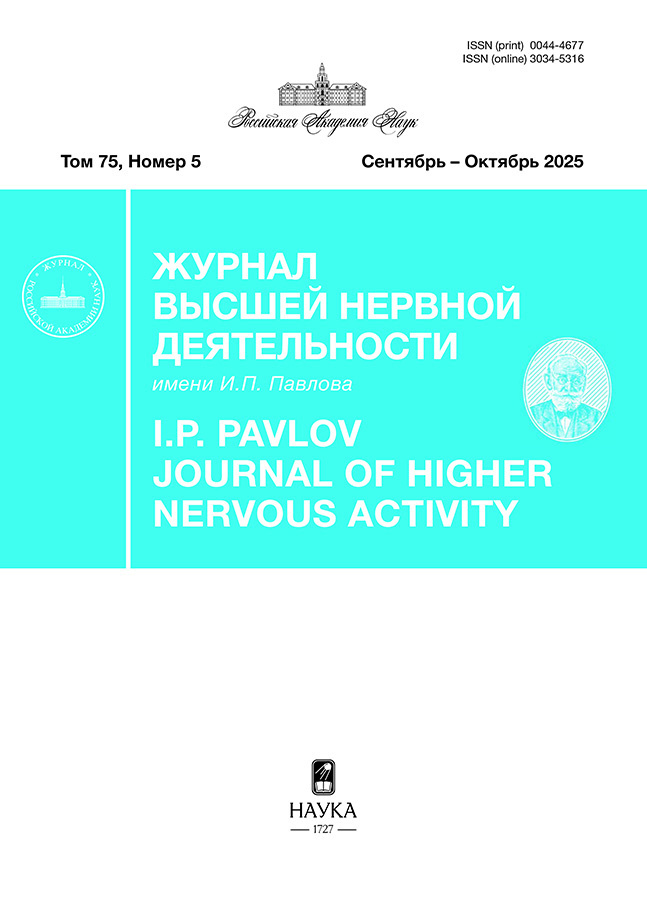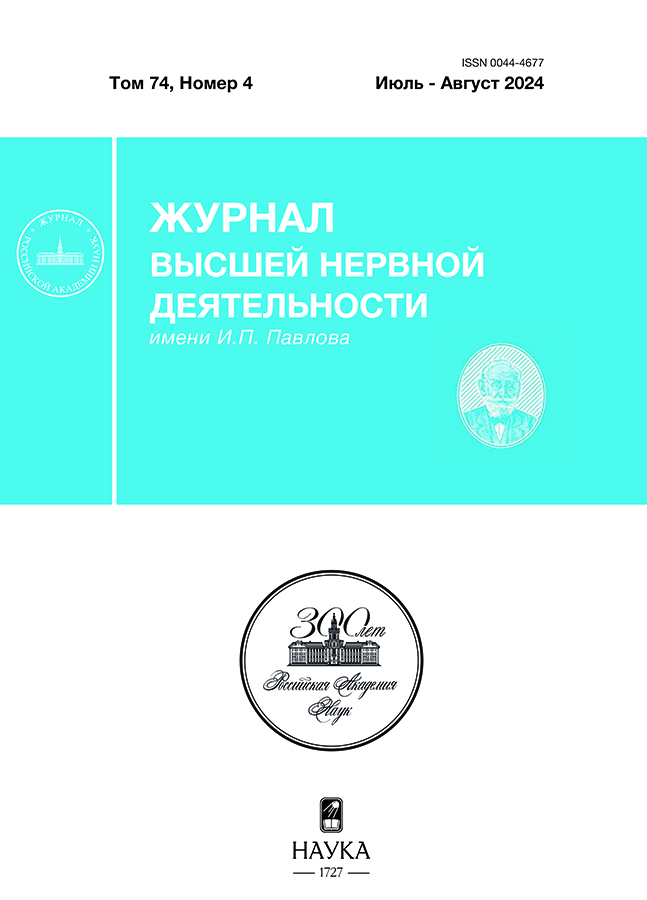EEG correlates of self-recognition in morphed faces: association with social anxiety
- Authors: Bocharov A.V.1, Savostyanov A.N.1, Saprygin A.E.1, Tamozhnikov S.S.1, Rudych P.D.1, Lebedkin D.A.1, Milakhina N.S.1, Merkulova E.A.1, Knyazev G.G.1
-
Affiliations:
- Scientific Research Institute of Neurosciences and Medicine
- Issue: Vol 74, No 4 (2024)
- Pages: 450-460
- Section: ФИЗИОЛОГИЯ ВЫСШЕЙ НЕРВНОЙ (КОГНИТИВНОЙ) ДЕЯТЕЛЬНОСТИ ЧЕЛОВЕКА
- URL: https://cardiosomatics.orscience.ru/0044-4677/article/view/652081
- DOI: https://doi.org/10.31857/S0044467724040065
- ID: 652081
Cite item
Abstract
Recognizing one’s own face is important for self-identification and is considered an indicator of self-consciousness. Social anxiety is related to special attention to self. The aim was to investigate the oscillatory dynamics associated with self-recognition/non-self-recognition in morphed faces and the correlation with social anxiety in these processes. During EEG recordings with 128 electrodes, 48 volunteers (31 females) recognized themselves in morphed faces. During self-recognition, a greater increase in theta rhythm was revealed in the time interval from 800 to 1500 ms than in the non-self-recognition condition. Based on the data on the relationship of the theta rhythm with attention and memory, it could be assumed that the increase in theta rhythm may be related to memory and attention processes when perceiving details, mismatches, and misrepresentation of one’s own face. Social anxiety was positively related to the magnitude of theta rhythm during self-recognition, it could be related to the increased attention that socially anxious people focus on themselves and distortions of their own face.
Keywords
Full Text
About the authors
A. V. Bocharov
Scientific Research Institute of Neurosciences and Medicine
Author for correspondence.
Email: bocharovav@neuronm.ru
Russian Federation, Novosibirsk
A. N. Savostyanov
Scientific Research Institute of Neurosciences and Medicine
Email: bocharovav@neuronm.ru
Russian Federation, Novosibirsk
A. E. Saprygin
Scientific Research Institute of Neurosciences and Medicine
Email: bocharovav@neuronm.ru
Russian Federation, Novosibirsk
S. S. Tamozhnikov
Scientific Research Institute of Neurosciences and Medicine
Email: bocharovav@neuronm.ru
Russian Federation, Novosibirsk
P. D. Rudych
Scientific Research Institute of Neurosciences and Medicine
Email: bocharovav@neuronm.ru
Russian Federation, Novosibirsk
D. A. Lebedkin
Scientific Research Institute of Neurosciences and Medicine
Email: bocharovav@neuronm.ru
Russian Federation, Novosibirsk
N. S. Milakhina
Scientific Research Institute of Neurosciences and Medicine
Email: bocharovav@neuronm.ru
Russian Federation, Novosibirsk
E. A. Merkulova
Scientific Research Institute of Neurosciences and Medicine
Email: bocharovav@neuronm.ru
Russian Federation, Novosibirsk
G. G. Knyazev
Scientific Research Institute of Neurosciences and Medicine
Email: bocharovav@neuronm.ru
Russian Federation, Novosibirsk
References
- Бочаров А.В., Лебедкин Д.А., Савостьянов А.Н., Князев Г.Г. Валидизация русских версий опросников: «шкала фокуса внимания на себе» и «шкала самосознания». Российский психологический журнал. 2023. 20 (3): 97–115.
- Каримова Е.Д., Смольская Д.В., Нараткина А.А. Активность зеркальной системы мозга у людей с депрессивным симптомокомплексом. Журн. высш. нерв. деят. 2023. 73(2): 230–241.
- Никитина И.В., Холмогорова А.Б. Социальная тревожность: содержание понятия и основные направления изучения. Часть 2. Социал. клин. психиатрия. 2011. 21 (1): 60–67.
- Abhang P.A., Gawali B.W., Mehrotra S.C. Introduction to EEG-and speech-based emotion recognition. Elsevier: Academic Press, 2016. 198 p.
- Aftanas L.I., Varlamov A.A., Pavlov S.V., Makhnev V.P., Reva N.V. Affective picture processing: event-related synchronization within individually defined human theta band is modulated by valence dimension. Neurosci. Lett. 2001. 303 (2): 115–118.
- Azoulay R., Berger U., Keshet H., Niedentha P.M., Gilboa-Schechtman E. Social anxiety and the interpretation of morphed facial expressions following exclusion and inclusion. Journ. Behav. Therapy Experim. Psychiatry. 2020. 66: 101511.
- Balconi M., Lucchiari C. Event-related potentials related to normal and morphed emotional faces. J. Psychol. 2005. 139 (2): 176–192.
- Bola M., Paź M., Doradzińska Ł., Nowicka A. The self‐face captures attention without consciousness: Evidence from the N2pc ERP component analysis. Psychophysiology. 2021. 58(4): e13759.
- Broesch T., Callaghan T., Henrich J., Murphy C., Rochat P. Cultural variations in children’s mirror self-recognition. JCCP. 2011. 42(6): 1018–1029.
- Bufalari I., Sforza A.L., Di Russo F., Mannetti L., Aglioti S.M. Malleability of the self: Electrophysiological correlates of the enfacement illusion. Sci. Rep. 2019. 9 (1): 1682.
- Cavanagh J.F., Shackman A.J. Frontal midline theta reflects anxiety and cognitive control: meta-analytic evidence. J. Physiol. Paris. 2015. 109: 3–15.
- Clark D.M., Wells A. A cognitive model of social phobia. Social phobia: Diagnosis, assessment and treatment. Ed. Heimberg R.G., Liebowitz M.R., Hope D.A., Schneier F.R. New York: Guilford Press, 1995. 69–93 pp.
- Cohen M.X. A neural microcircuit for cognitive conflict detection and signaling. Trends Neurosci. 2014. 37(9): 480.
- Delorme A., Makeig S. EEGLAB: an open source toolbox for analysis of single- trial EEG dynamics including independent component analysis. J. Neurosci. Methods. 2004. 134: 9.
- Devue C., Bredart S. The neural correlates of visual self-recognition. Conscious. Cogn. 2011. 20: 40–51.
- Dosenbach N.U., Fair D.A., Cohen A.L., Schlaggar B.L., Petersen, S.E. A dual-networks architecture of top-down control. Trends Cogn. Sci. 2008. 12 (3): 99–105.
- Engel A. K., Fries P. Beta-band oscillations–signalling the status quo? Curr. Opin. Neurobiol. 2010. 20(2): 156–165.
- Fischer M., Moscovitch M., Alain C. A systematic review and meta‐analysis of memory‐guided attention: Frontal and parietal activation suggests involvement of fronto‐parietal networks. WIREs: Cognitive Science. 2021. 12 (1): e1546.
- Feinberg T.E., Keenan J.P. Where in the brain is the self? Conscious. Cogn. 2005. 14(4): 661-678.
- Fenigstein A., Scheier M.F., Buss A.H. Public and private self-consciousness: Assessment and theory. J. Consult. Clin. Psychol. 1975. 43 (4): 522–527.
- Fenigstein A. On the nature of public and private self‐consciousness. Journal of personality. 1987. 55 (3): 543–554.
- Frick A., Howner K., Fischer H., Eskildsen S.F., Kristiansson M., Furmark T. Cortical thickness alterations in social anxiety disorder. Neurosci. Lett. 2013. 536: 52–55.
- Gallup G.G. Self recognition in primates: a comparative approach to the bidirectional properties of consciousness. Am. Psychol. 1977. 32: 329–338.
- Hattingh C.J., Ipser J., Tromp S.A., Syal S., Lochner C., Brooks S.J., Stein D.J. Functional magnetic resonance imaging during emotion recognition in social anxiety disorder: an activation likelihood meta-analysis. Front. Hum. Neurosci. 2013. 6: 347.
- Hipp J.F., Engel A.K., Siegel M. Oscillatory synchronization in large-scale cortical networks predicts perception. Neuron. 2011. 69 (2): 387–396.
- Hu C., Di X., Eickhoff S.B., Zhang M., Peng K., Guo H., Sui J. Distinct and common aspects of physical and psychological self-representation in the brain: A meta-analysis of self-bias in facial and self-referential judgements. Neurosci. Biobehav. Rev. 2016. 61: 197–207.
- Keenan J.P., Rubio J., Racioppi C., Johnson A., Barnacz A. The right hemisphere and the dark side of consciousness. Cortex. 2005. 41 (5): 695–704.
- Kircher T.T., Senior C., Phillips M.L., Rabe-Hesketh S., Benson P.J., Bullmore E.T., Brammer M., Simmons A., Bartels M., David A.S. Recognizing one’s own face. Cognition. 2001. 78 (1): 1–15.
- Klimesch W. EEG alpha and theta oscillations reflect cognitive and memory performance: a review and analysis. Brain Res. Rev. 1999. 29 (2): 169–195.
- Knyazev G.G. Motivation emotion and their inhibitory control mirrored in brain oscillations. Neurosci. Biobehav. Rev. 2007. 31: 377.
- Knyazev G.G., Bocharov A.V., Levin E.A., Savostyanov A.N., Slobodskoj-Plusnin J.Y. Anxiety and oscillatory responses to emotional facial expressions. Brain Res. 2008. 1227: 174–188.
- Knyazev G.G., Slobodskoj-Plusnin J.Y., Bocharov A.V. Event-related delta and theta synchronization during explicit and implicit emotion processing. Neuroscience. 2009. 164: 1588–1600.
- Lewis M. Self-conscious emotions and the development of self. Affect: Psychoanalytic Perspectives. Ed. Shapiro T., Emde R.N. Madison, CT: International Universities Press. Inc., 1992. 45–73 pp.
- McNaughton N., Swart C., Neo P., Bates V., Glue P. Anti-anxiety drugs reduce conflict-specific “theta”–a possible human anxiety-specific biomarker. J Affect. Disord. 2013. 148: 104–111.
- McManus F., Sacadura C., Clark D.M. Why social anxiety persists: An experimental investigation of the role of safety behaviours as a maintaining factor. Journ. Behav. Therapy Experim. Psychiatry. 2008. 39 (2): 147–161.
- Morin A. Self-awareness and the left hemisphere: The dark side of selectively reviewing the literature. Cortex. 2007. 43 (8): 1068–1073.
- Morita T., Itakura S., Saito D.N., Nakashita S., Harada T., Kochiyama T., Sadato N. The role of the right prefrontal cortex in self-evaluation of the face: a functional magnetic resonance imaging study. J. Cogni. Neurosci. 2008. 20 (2): 342–355.
- Morrison A.S., Heimberg R.G. Social anxiety and social anxiety disorder. Annu. Rev. Clin. Psychol. 2013. 9: 249–274.
- Oostenveld R., Praamstra P. The five percent electrode system for high-resolution EEG and ERP measurements. Clin. Neurophysiol. 2001. 112 (4): 713–719.
- Platek S.M., Wathne K., Tierney N.G., Thomson J.W. Neural correlates of self-face recognition: an effect-location meta-analysis. Brain Res. 2008. 1232: 173–184.
- Sakihara K., Gunji A., Furushima W., Inagaki M. Event-related oscillations in structural and semantic encoding of faces. Clin. Neurophysiol. 2012. 123 (2): 270–277.
- Spitzer B., Haegens S. Beyond the status quo: a role for beta oscillations in endogenous content (re)activation. Eneuro. 2017. 4 (4).
- Shadli S.M., Kawe T., Martin D., McNaughton N., Neehoff S., Glue P. Ketamine effects on EEG during therapy of treatment-resistant generalized anxiety and social anxiety. IJNP. 2018. 21 (8): 717–724.
- Sugiura M. Three faces of self-face recognition: Potential for a multi-dimensional diagnostic tool. Neurosci. Res. 2015. 90: 56–64.
- Uddin L.Q., Kaplan J.T., Molnar-Szakacs I., Zaidel E., Iacoboni M. Self-face recognition activates a frontoparietal “mirror” network in the right hemisphere: an event-related fMRI study. NeuroImage. 2005. 25: 926–935.
- Uddin L.Q., Iacoboni M., Lange C., Keenan J.P. The self and social cognition: the role of cortical midline structures and mirror neurons. Trends Cogn. Sci. 2007. 11 (4): 153–157.
- van der Molen M.J., Harrewijn A., Westenberg P.M. Will they like me? Neural and behavioral responses to social-evaluative peer feedback in socially and non-socially anxious females. Biol. Psychol. 2018. 135: 18–28.
- Verosky S.C., Todorov A. Differential neural responses to faces physically similar to the self as a function of their valence. NeuroImage. 2010. 49 (2): 1690-1698.
- Wrobel A. Beta activity: a carrier for visual attention. Acta Neurobiol. Exp. 2000. 60: 247–260.
Supplementary files














